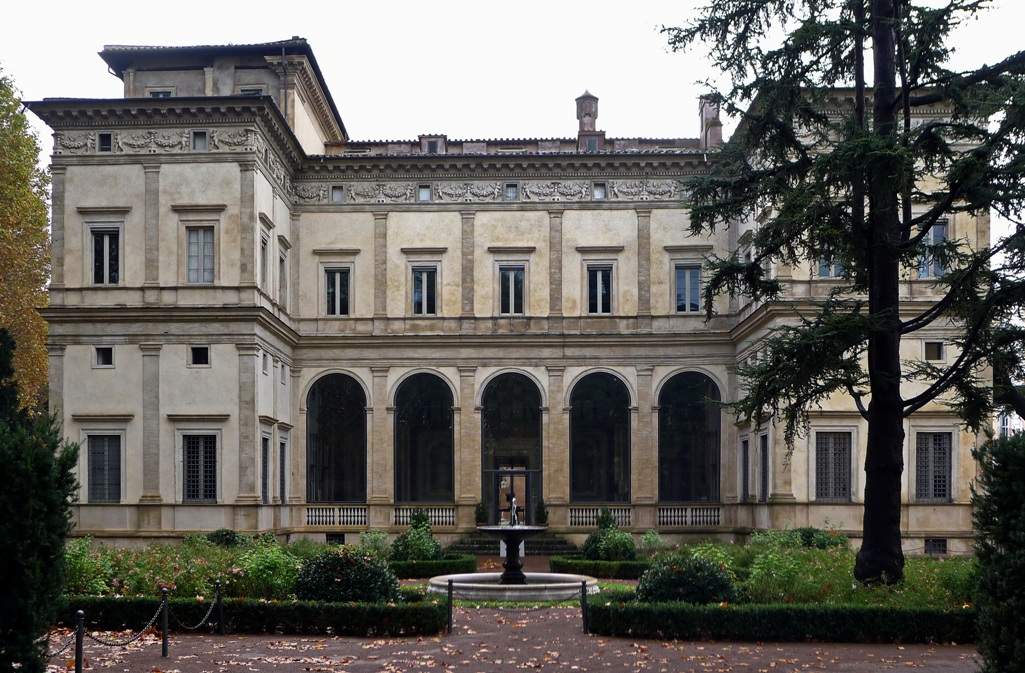Villa Farnesina – Rome
Le Delizie also known as “The Delights” was the first name given to this house, which was known in Renaissance days as the top party place in Rome. It was constructed by Agostino Chigi, a banker for the Popes known as the richest man in the World. On the same spot at the time of 44 B.C. was a villa in which Cleopatra continued to follow Julius Caesar.
Chigi was an ardent patron of the arts and in 1506 he invited the most renowned designer (Baldassare Peruzzi) and the best artists to design a lush garden and a house brimming with mythological love scenes that would draw the attention of his guests. Shows featuring dancers and singers were staged in this venue as well as lavish banquets. To conclude the evening, Chigi ordered his servants to throw his silverware and china in the Tiber. What did the guests not know is that Chigi had a net to catch the entire mess?
The main attractions of Chigi’s events were Rome’s most adored courtesans. The beautiful ladies, who were dubbed “honest prostitutes,” in addition to offering their usual services, were able to recite classical poems at the flick of a switch and entertain their admirers with lutes and violins.
They were well-liked by Rome’s wealthy bachelors which included merchant traders as well as priests. As movie stars, as courtesans were cruising public streets with their luxurious carriages, people would race out to look at their exquisite attire, jewelry, and hairstyles.
Imperia is the most well-known courtesans and was a favorite of Chigi’s. He was planning to live with her in this house when he decided to construct it. The painter Raphael who also spent long hours with Imperia used her as a model for one of the very first frescoes that you’ll see within the Loggia of Galatea. The half-naked image of the sea Nymph (surprisingly strong and soft) is taken from the Greek myth that begins with Cyclops Polyphemus falling over Galatea.
For Polyphemus Galatea, the goddess became enamored with a shepherd who was mortal, Acis. When Polyphemus noticed the two couples savoring in the midst of the night, he turned and hurled a stone at the couple which killed Acis. It was Galatea’s blood that his deceased lover was transformed into a river which she floats on as she rides away proudly free of Polyphemus. Raphael’s character Imperia wasn’t as impressive. The courtesan was in love with several men in her life, besides Chigi and became enamored in one.
When he was bored with her Imperia believed she would lose beauty. When she was 26, she took poison and passed away. The exact date of her death was on August 15 (coincidentally that was the day of Mary’s Assumption to heaven) in Rome there was a massive storm that had people living in the city claiming that Jupiter had come down to steal their beautiful beauty.
Imperia’s picture is seen again upstairs in the villa in which Sodoma’s artist painted Chigi’s room with images from the life and times of Alexander the Great. The Wedding of Alexander and Roxanne is an arousing sexual experience as Roxanne’s clothing is pulled at by putti while Alexander is waiting for his bride. Chigi and Imperia had split before her suicide. The couple had gone to Venice and bought himself another lady to court, Francesca.
The couple moved to the area after having four children after which the Pope demanded they get married. Their wedding was among the largest weddings that ever took place at the villa, and included Pope Leo and 12 cardinals attending.
In all the wonderful celebrations held at Le Delizie, guests would be able to enter via the Loggia of Psyche which was the gorgeous setting of the villa which was originally open to the garden and was not closed as it is today. Raphael created it, but he did not have the time to paint it as the artist was busy with his other projects and also his relationship with Margherita Luti the daughter of a baker who lived in the same neighborhood.
His students finished it by bringing into the surrounding nature by embellishing the landscape with beautiful flowers, lush greenery, and fruits, all of which are surrounded by frescos telling stories of romance between Amore as well Psyche. This myth is in line with the Renaissance ideal of joining both the Divine (Amore) together with the mortal mind/soul (Psyche).
The goddess Venus is obviously involved. And after several difficulties, the main protagonists have a union celebration on the ceiling. Following the death of Chigi, the Farnese family purchased Le Delizie, renamed it Villa Farnesina, and set about connecting it to their palazzo close to the Campo dei Fiori. The bridge that was planned wasn’t finished, but part of it was constructed into the stunning archway, which is dripping with vines across the Via Giulia.


